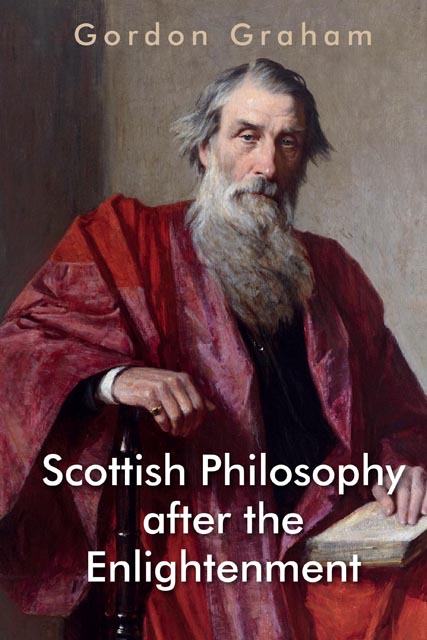Book contents
- Frontmatter
- Contents
- Preface and Acknowledgements
- Series Editor’s Introduction
- A Note on Women in Scottish Philosophy: Mrs Oliphant
- A Chronology of Scottish Philosophy after the Enlightenment
- 1 An Autobiographical Prologue
- 2 Sir William Hamilton and the Revitalisation of Scottish Philosophy
- 3 James Frederick Ferrier and the Course of Scottish Philosophy
- 4 Psychology and Moral Philosophy: Alexander Bain
- 5 Thomas Carlyle and the Philosophy of Rhetoric
- 6 Hegelianism and its Critics
- 7 Scottish Philosophy’s Progress
- 8 Religion, Evolution and Scottish Philosophy
- 9 The Gifford Lectures and the Re-affirmation of Theism: Alexander Campbell Fraser
- 10 The Culmination of Scottish Philosophy: A. S. Pringle-Pattison
- 11 John Macmurray and the Self as Agent
- Bibliography
- Index
5 - Thomas Carlyle and the Philosophy of Rhetoric
Published online by Cambridge University Press: 07 June 2023
- Frontmatter
- Contents
- Preface and Acknowledgements
- Series Editor’s Introduction
- A Note on Women in Scottish Philosophy: Mrs Oliphant
- A Chronology of Scottish Philosophy after the Enlightenment
- 1 An Autobiographical Prologue
- 2 Sir William Hamilton and the Revitalisation of Scottish Philosophy
- 3 James Frederick Ferrier and the Course of Scottish Philosophy
- 4 Psychology and Moral Philosophy: Alexander Bain
- 5 Thomas Carlyle and the Philosophy of Rhetoric
- 6 Hegelianism and its Critics
- 7 Scottish Philosophy’s Progress
- 8 Religion, Evolution and Scottish Philosophy
- 9 The Gifford Lectures and the Re-affirmation of Theism: Alexander Campbell Fraser
- 10 The Culmination of Scottish Philosophy: A. S. Pringle-Pattison
- 11 John Macmurray and the Self as Agent
- Bibliography
- Index
Summary
I
It would be difficult to exaggerate the degree to which Thomas Carlyle was lionised in the last years of his life. No fewer than 119 eminent people signed the list assembled by David Masson in celebration of his eightieth birthday. It included prestigious scientists (Charles Darwin and Thomas Huxley), poets (Alfred Tennyson and Robert Browning) and novelists (George Eliot and Anthony Trollope), as well as almost all the professors of philosophy in Scotland. This was in 1875, despite the fact that after the death of his wife Jane Welsh Carlyle in 1866, Carlyle published very little. The little he did publish, however, was avidly seized upon by the reading public. What might be considered his ‘last word’, the anti-reform pamphlet Shooting Niagara, published in 1867, sold 4,000 copies in just three weeks. The London house he had occupied for forty years became a place of pilgrimage for a constant stream of people from the highest social, political, literary and even royal circles. They all wanted to see ‘the Sage of Chelsea’ and hear the long monologues on cultural and political themes that had become his trademark.
II
Carlyle spent the first thirty-eight years of his life in Scotland. Self-employed for more than a decade, he had been trying to gain recognition and acceptance as a writer and thinker. In 1834, when the struggle was beginning to succeed, he and his wife left the isolation of Craigenputtock, a small farm in Dumfriesshire, and moved to Chelsea, then a suburb on the edge of London. Their new location did not change things immediately, but the tide finally turned in Carlyle’s favour when he published his history of The French Revolution in 1837. Thereafter he steadily came to be accorded immense intellectual stature, and towards the end of his life was held worthy of receiving the highest academic awards and political honours (most of which he declined).
The Cambridge edition of his Collected Works runs to thirty volumes, and the peak of this literary achievement was a six-volume biography of Frederick the Great. Carlyle devoted thirteen years to its composition, an enormous endeavour undertaken at considerable personal cost, especially to his wife. When it was finally published, it proved a huge success and made him rich. The first two volumes appeared in 1858 to critical acclaim.
- Type
- Chapter
- Information
- Scottish Philosophy after the Enlightenment , pp. 95 - 112Publisher: Edinburgh University PressPrint publication year: 2022



